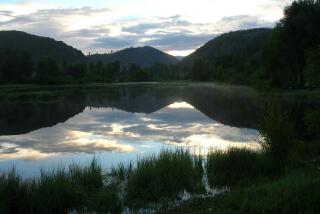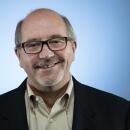Eisner Shows His Softer Side
Given the acrimonious events of the recent past, some might have trouble picturing Michael Eisner warming himself by a campfire -- unless maybe Michael Ovitz were there, too, turning on a spit.
Eisner is, after all, the guy who once called his old pal Ovitz “a psychopath” and referred to Jeffrey Katzenberg, his erstwhile Walt Disney Co. protege, as “the little midget.”
Small wonder that some find it hard to embrace the collegial image the outgoing Disney chief dons in his new memoir “Camp,” a 182-page, all-kumbaya-all-the-time ode to Keewaydin, the idyllic Vermont getaway where he spent the summers of his youth on the shores of Lake Dunmore.
It was at Keewaydin, Eisner writes, that he learned the value of mutual respect, teamwork and leadership, along with such enduring life lessons as “Help the other fellow” and “Be a fair winner and a good loser.”
Oh, and “Avoid crabbing.”
That one could come in especially handy, considering the book’s early performance.
Since the June 1 release of “Camp,” Eisner has made the rounds of television talk shows and morning news programs, appearing on PBS’ “The Charlie Rose Show,” NBC’s “Today” and ABC’s “Good Morning America” and “Live With Regis and Kelly.” He’s also reached out to radio listeners, on NPR’s “Morning Edition” and “Talk of the Nation” and ABC Radio’s Sean Hannity show, among others.
Despite the book’s heavy promotion, sales have been nothing to write home about.
As of late last week, a month after “Camp’s” release, the $22.95 book had sold just 5,431 copies, according to Nielsen BookScan, which tracks 4,500 retail and Internet booksellers, including Borders, Barnes & Noble, Costco, Target, Kmart and Amazon.com. Early sales have taken a relatively small bite out of Warner Books’ first printing of 101,000 copies.
“Right now, it’s not on a bestseller trajectory,” said John Kremer, editor of the Book Marketing Update newsletter. “It should be selling more than that, given all the promotion they’re doing.”
Eisner, who will donate the book’s proceeds to his family’s foundation, said he wasn’t sweating the numbers.
“What I’m pretty sure is, it is not going to be a No. 1 bestseller for 26 weeks,” he said in an interview. “And I’m also pretty sure it’s not a disaster. So it’s somewhere in the middle.”
“Camp” was the brainchild of Time Warner Book Group Chief Executive Laurence Kirshbaum. Eisner said Kirshbaum had assured him that it was doing well. But after 40 years in show business, Eisner said, he understands that the phrase “it’s doing well” can be ambiguous.
“I’ve said that to a lot of people in my career,” he said. “It could mean anything. It could mean, ‘Jump out the window -- you’ve sold three copies.’ It could mean, ‘Hey, it’s really taking off.’ ”
Although “Camp” hasn’t rocketed off the charts, it’s doing better than BookScan’s data would indicate, Kirshbaum said.
BookScan’s numbers, he said, “have some major gaps” because they do not reflect sales at some large retailers, including Wal-Mart. “I know the numbers are not huge yet,” Kirshbaum said, “but we feel we have sold 25,000 to 35,000 copies in the first few weeks.”
“Camp” was to be released in June 2004, shortly after a shareholder uprising headed by Walt Disney’s nephew, Roy E. Disney, led to Eisner’s ouster as chairman. But Kirshbaum said he didn’t want it “to come out in the eye of the hurricane.”
Warner probably will spend $100,000 to a $150,000 to promote “Camp,” which Kirshbaum estimates must sell 40,000 to 50,000 copies to break even, and about 100,000 to be a bestseller.
“It’s definitely a hit in Vermont,” Kirshbaum said. “Unfortunately, Vermont is not one of the major population centers of the United States.”
Unlike Eisner’s 1998 autobiography, “Work in Progress,” his latest effort makes almost no reference to the Disney chief’s lucrative and sometimes controversial business career, except for a fly-by mention of “distractions from people who could have used a few summers at camp earlier in their lives.”
“Work in Progress” mostly details Eisner’s professional career, while “Camp” draws on his memories of Keewaydin and its sage leader, Alfred Hare, a.k.a. Waboos, and the experiences of two underprivileged young campers from Orange County.
So far, reviews of “Camp” have been mixed, with some describing it as movingly nostalgic and others calling it as sticky-sweet as the stuff tapped from Vermont maples in spring.
Most have contrasted “Camp” to the recently released “DisneyWar,” a behind-the-curtain look at Disney that casts Eisner in a very un-Keewaydin light, as petty, vindictive and controlling. In its first three weeks it sold 32,500 copies, or about eight times as many as “Camp” did in a similar stretch.
“Given the presence of James B. Stewart’s withering Eisner expose ‘DisneyWar’ on the bestseller lists, ‘Camp’ comes off as strange and almost creepy -- so full of apple-pie sentiments that it leaves the impression of an embattled executive straining to prove that a big heart beats beneath his slick suit,” read an Outside magazine review.
Eisner calls the Stewart book “a fiction” and a “misrepresentation of the facts,” and he bristles at the notion he wrote the sentimental “Camp” to buff his image as he exits the top job at Disney. “If anything, it’s a much higher risk than writing a business book,” he said.
Eisner’s association with Keewaydin dates to 1949, when he first visited the camp with his father, Lester, a New York lawyer and entrepreneur who attended as a boy. The next summer, 8-year-old Michael followed Lester’s path to Keewaydin, just as Eisner’s three sons followed his, decades later.
Eisner spent many of the next 15 summers as a Keewaydin camper and “staffman,” canoeing, hiking and trekking into the wilderness before embarking on a career in show business.
Following successful stints at ABC and Paramount, Eisner in 1984 was named chief executive at Disney. After two decades in which annual revenue grew from $1.5 billion to $30.8 billion -- and in which Eisner’s image took a couple of public beatings for his rough management style -- he will relinquish that job in October to Robert Iger, his hand-picked successor.
Martin Kaplan, who spent 12 years as a Disney executive beginning in 1985, said he learned early on about Keewaydin’s effect on Eisner. Kaplan said both Eisner and Katzenberg, the former head of Walt Disney Studios, were big summer camp fans.
“They endlessly told stories about what had happened to them at camp, usually involving some degree of mischief, and always nostalgically,” said Kaplan, now an associate dean of the USC Annenberg School for Communication. “In fact, the very first project I worked on involved a movie in development about summer camp.”
In all, Kaplan said, Disney cranked out at least three summer camp movies during Eisner’s tenure, Kaplan said, including “Indian Summer,” “Camp Nowhere” and “Heavyweights,” about a camp for fat people.
Eisner said he first memorialized his affinity for Keewaydin when he wrote stories about it for his children. Since high school, he said, he has believed that any idea worth sharing should be committed to writing.
“Unless you can take your scrambled synapses of thought and articulate them on paper, they are not motivational,” he said. “They don’t get you from A to B.”
They also don’t get you into hot water, as happened when missives Eisner intended to be private wound up in the public domain, including derogatory references to Ovitz and Katzenberg that surfaced in lawsuits.
“I have been criticized for writing too much,” Eisner said with a smile.
The impetus for the book came from a fellow camper, Kirshbaum, the Warner Books CEO who also is a member of the Order of the Silver Moccasin at Camp Indianola in Wisconsin. He heard Eisner extolling the virtues of Keewaydin in a speech a few years ago.
“I was so impressed by his boyish enthusiasm that I thought it would make a wonderful book,” he said. “When he talks about camp he really gets into a different zone.”
Much of “Camp” follows the story of the two Orange County boys, Pepe Molina and Quenton Spratley. Along with two girls, they were the first kids the Eisner Foundation sent to Keewaydin, where a four-week session costs $4,700 and eight weeks runs $6,250.
The foundation, overseen by Eisner’s wife Jane and directed by his sons Breck, Eric and Anders, has given more than $30 million to charity since 1999, tax records show. The contributions include millions of dollars to nonprofit causes that benefit children, including Boys & Girls Clubs, the Boy Scouts, children’s hospitals and schools.
Keewaydin, however, was largely absent from the lengthy list of recipients until the foundation sponsored the kids featured in Eisner’s book. One reviewer took him to task for it.
“Study Eisner’s compensation package for the past 20 years and you might wonder why he hasn’t filled this upper-class refuge with poor inner-city kids -- kids he suddenly took an interest in after his ‘nice guy’ reputation had been savaged during his court battles,” read a review in the Orlando Sentinel, Disney World’s local paper in Florida.
Eisner said the foundation didn’t send children to the Vermont camp earlier because it supports charitable causes almost exclusively based in Southern California. This year, the foundation is sponsoring 17 youngsters.
Dave Wilk, who runs Disney GOALS, the after-school athletics program from which Pepe and Quenton were selected, said Eisner’s “compassion for children is legendary.” All of the Eisners have been involved with the kids who have gone to Keewaydin, Wilk said, with Michael Eisner taking some there personally.
“A month in Vermont for kids coming out of one of these neighborhoods is fantastic,” Wilk said.
Pepe and Quenton, also known as “Q,” recalled a meeting with Eisner at Disney’s Burbank headquarters in 2002 for a pre-camp pep talk and slideshow presentation. Eisner later spent a couple of days at camp, but most of the boys’ experiences were chronicled by Aaron Cohen, a television writer and producer hired to help write the book.
Both boys have returned to Keewaydin every year since and can continue through their teens, thanks to a combination of funding by the foundation and the camp’s endowment. Both also have acquired an Eisner-like affection for the place.
“I think about it every day after I come home, until I go back again the next year,” said Quenton, 13, of Fullerton who left for camp last week. “The closer it gets, the longer it takes for the days to go by.”
Pepe, who is 14 and lives in Anaheim, will head for Vermont later this month.
“It’s a great experience,” he said. “I like canoeing and kayaking and things I don’t normally do here. And I like meeting new people from around the world.”
Whether or not “Camp” becomes a commercial success is of little consequence, Eisner said, because he didn’t write it to make money or impress anyone, anyway. Bromides and all, the book “is what it is,” he said, and he wrote it because he thought others might benefit from the camping experience.
Some day, he might write a big business book. He has also toyed with the idea of doing one on another subject close to his heart: Ohio.
Next to Disney and Keewaydin, he said, some of his best times ever were there, at Denison University.
“It was camp for grown-ups,” he said.
More to Read
Sign up for our Book Club newsletter
Get the latest news, events and more from the Los Angeles Times Book Club, and help us get L.A. reading and talking.
You may occasionally receive promotional content from the Los Angeles Times.








